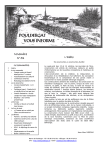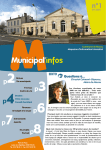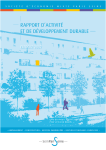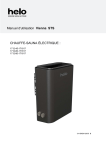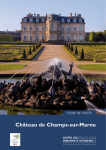Download No 6 (3 Feb. 2002)
Transcript
SUNDAY/DIMANCHE, 3 FÉVRIER/FEBRUARY, 2002 ISSUE 6/NUMÉRO 6 saltlake2002.com F E AT USR ES OMMAIRE 2 Heralded Photographer Un photographe de renom 3 Question of the Day Question du jour 4 Visions from the Village Images du village 6 Experienced Chef Un chef d’expérience 8 Olympic Aid Aide Olympique Sarah Morton T h e O ff i c i a l N e w s p a p e r o f t h e S a l t L a k e 2 0 0 2 O l y m p i c V i l l a g e | L e J o u r n a l o ff i c i e l d u v i l l a g e d e s J e u x O l y m p i q u e s d ’ h i v e r à S a l t L a k e C i t y e n 2 0 0 2 SUNDAY/DIMANCHE, 3 FÉVRIER/FEBRUARY, 2002 Heralded Art Photographer Raymond Meeks Takes Athlete Portraits at Olympic Village Portraits d'athlètes par le célèbre photographe Raymond Meeks au village olympique Raymond Meeks C.J. Whittaker Raymond Meeks resulting in glass plate negatives. Meeks explains his special process: “I’ll shoot conventional film and when I feel like we’ve evolved to the point that this is the picture that I’d like to have of the individual [athlete], I’ll run up to our studio and coat a plate and come down and make the exposure.” Meeks also plans to coordinate with athletes and coaches to shoot some photographs in and around Salt Lake City and Park City with pristine landscapes as the backdrop. After an athlete is photographed, Meeks will provide him or her with a 4 x 5 photograph with his signature. He says he feels this is his way of giving the athletes something in return for their contribution to the process. “I like to think about it as being the ambassador to the Games,” says Meeks. “But just to give something back, too, because the athletes will make the book. It is just a polite thing to do.” Meeks, who lives in Montana with his wife and two children, started photographing when he realized there were no good ENGLISH Salt Lake 2002 has engaged some of the nation’s most eminent art photographers for its Official Commemorative Book, The Fire Within. The book, which will be published after the Games, will chronicle the major stories of triumph, defeat, passion and international goodwill of the Salt Lake 2002 Games. Raymond Meeks is photographing in the Olympic Village. When asked what he wants to capture through his images, Meeks explained he hopes to engage in a collaborative process with the athletes to create unique and candid portraits. “A good portrait looks easy, but portraits are really challenging,” says Meeks. “The hardest thing to do is to make a portrait of somebody that actually captures what is particular or characteristic of that person.” For his Olympic Village coverage, Meeks will use 8 x 10 and 4 x 5 cameras with turn-ofthe century lenses and an artisan method of processing the film, 2 pictures of his grandmother. He bought a 35-millimeter camera and some black and white film, and began making pictures. Today, he is renowned in the photographic arts community for his unique, artisan approach to his craft. For The Fire Within, Meeks will be joined by his colleagues, which include John Huet, Sheila Metzer, David Burnett, Tibor Nemeth, Andy Anderson, Albert Colantonio, Steve Currie, Ian Logan, Elizabeth O’Donnell and Michael Seamans. A team of top writers will report on the compelling stories that accompany the splendid photography, bringing the Games’ 17 days of action and drama to life for an enduring look at the Games. Athletes interested in obtaining a copy of The Fire Within may visit saltlake2002.com. —Scott Laury FRANÇAIS Le comité de Salt Lake 2002 a fait appel à l'un des plus grands photographes d’art américains pour illustrer le livre commémoratif des Jeux, «The Fire Within», qui paraîtra après l'événement. Cet ouvrage retracera les moments forts des Jeux Olympiques de Salt Lake City et rendra compte des exploits, des échecs, des passions et de la fraternité entre les peuples. Raymond Meeks prendra ses photos au village olympique. Lorsqu'on lui demande ce qu'il cherchera à saisir dans ses oeuvres, il répond qu'il espère établir une relation de complicité avec les athlètes, pour créer des portraits à la fois uniques et authentiques. «Il peut sembler facile de faire un bon portrait. Mais en réalité, c'est très difficile», assure le photographe. «C'est une gageure de faire un portrait qui capte ce qu'il y a de particulier ou de caractéristique chez quelqu'un.» Pour ses photos dans le village olympique, Raymond Meeks utilisera des appareils 8 x 10 pouces (20 x 25 cm) et 4 x 5 pouces (10 x 12 cm) équipés de modèles de lentilles du début du siècle. Il emploiera une méthode de développement artisanale, pour obtenir des négatifs sur plaque de verre. Raymond Meeks explique sa façon de procéder : «J'utiliserai une pellicule classique et quand on sera sur le point d'avoir la photo que je recherche, je courrai au studio pour sensibiliser une plaque et je reviendrai faire la photo.» Raymond Meeks compte également organiser avec les athlètes et les entraîneurs des séances photos à Salt Lake City, Park City et alentour, sur The Official Newspaper of the Salt Lake 2002 Olympic Village fond de nature sauvage. Il remettra à chaque athlète photographié un tirage format 10 x 12, avec sa signature. Pour lui, c'est une façon de remercier les athlètes d'avoir apporté leur contribution. «Ces photos sont pour moi des ambassadrices des Jeux», explique-t-il. «Mais ce sont aussi des cadeaux pour les athlètes, car ce sont eux qui font le livre. C'est une question de politesse.» Raymond Meeks, qui vit dans le Montana avec son épouse et ses deux enfants, a commencé à exercer son art lorsqu'il s'est rendu compte qu'il n'arrivait pas à trouver de bonnes photos de sa grandmère. Il acheta alors un appareil 35 millimètres et une pellicule noir et blanc et se mit à prendre des photos. Aujourd'hui, il jouit d'une grande renommée parmi ses pairs pour l'originalité de son approche artisanale. De nombreux photographes travailleront avec lui sur l'ouvrage «The Fire Within»: John Huet, Sheila Metzer, David Burnett, Tibor Nemeth, Andy Anderson, Albert Colantonio, Steve Currie, Ian Logan, Elizabeth O'Donnell et Michael Seamans. Ils pourront compter sur une équipe de rédacteurs de premier ordre pour accompagner leurs oeuvres de récits palpitants, qui nous feront revivre l'incroyable aventure des Jeux. Les athlètes peuvent se procurer une copie de l'ouvrage «The Fire Within» en se rendant sur le site Internet saltlake2002.com. —Scott Laury SUNDAY/DIMANCHE, 3 FÉVRIER/FEBRUARY, 2002 QU E ST ION OF TH E DAY LA QUESTION DU JOUR Q Who has inspired you? Qui vous a inspiré? “My brother. He was doing skiing. I saw him and I went to try. Since then, I couldn’t stop.” –Eva Tofalvi, biathlon, Romania «Mon frère. Je l’ai vu faire du ski et j’ai décidé d’essayer moi aussi. Je n’ai jamais arrêté d’en faire depuis.» —Eva Tofalvi, biathlon, Roumanie Raymond Meeks “My dad, because he played the sport before me and he was my coach.” Raymond Meeks –Robert Zukas, ice hockey, Austria «Mon père, parce qu’il a joué au hockey avant moi et qu’il était mon entraîneur.» —Robert Zukas, hockey sur glace, Autriche Meeks Invites Athletes to Collaborate Participer au projet de Raymond Meeks: mode d’emploi ENGLISH Athletes interested in collaborating with Meeks to have their portraits made may stop by the Media Meeting Area on the first floor of Building 607 in the International Zone between the hours of 10:00 and 14:00 starting 4 February. Meeks says he is open to athletes who come with an idea of how they want to be T H E O LY M P I C R E C O R D Editor in Chief Matt Canham Managing Editors Kathryn Cowles Eric Walden Photo Editor Matt Hatfield Photographers Sarah Morton C.J. Whittaker Reporters Rory Brunner Jeremy Mathews Wynne Parry Laura Weiss Jared Whitley Business Manager Adam Ward Salt Lake 2002 Staff Senior Editor Scott Laury Art Director George Rivera Translation Manager Daniel Glon Account Executive Heather Campbell Olympic Village Liaison Tauni Everett Creative Director Libby Hyland Design Manger Ron Stucki Executive Editor Sarah JM Tuff photographed. He prefers to capture them as individuals in their normal, everyday attire, unless the athletes insist on wearing their uniforms. Meeks also welcomes any good luck charms or other pre-event rituals they would like to share with him. If desired, athletes are welcome to bring a coach, teammate or friend to be included in the portrait. Pending time and material, Meeks hopes to photograph 200 athletes while he is here in Salt Lake City. A selection of the athlete portraits will appear in a later edition of this newspaper and may be published in The Fire Within after the Games. —Scott Laury FRANÇAIS Les athlètes qui souhaiteraient poser pour Raymond Meeks sont priés de se présenter entre 10h et 14h à partir du 4 février au point de rencontres médias, dans la zone internationale, au premier étage du bâtiment 607. Le photographe est ouvert aux suggestions des athlètes sur la façon de réaliser leur portrait. Il préfère photographier ses sujets dans leurs vêtements de tous les jours, sauf si les athlètes insistent pour porter leur tenue de compétition. En outre, il est intéressé par les éventuels porte-bonheur ou rituels observés par les athlètes avant les épreuves. S'ils le désirent, les athlètes peuvent venir avec un entraîneur, un coéquipier ou un ami avec qui ils souhaiteraient être photographiés. Raymond Meeks prévoit, s’il dispose du temps et des conditions matérielles nécessaires, de photographier 200 athlètes durant son séjour à Salt Lake City. Une sélection de ses portraits paraîtra dans ce journal, et, le cas échéant, dans l'ouvrage «The Fire Within», qui sera publié après les Jeux. —Scott Laury V I L L AG E W E AT H E R “In alpine skiing, I was inspired by Ingmar Stenmark from Sweden and Alberto Tomba from Italy.” –Enis Becirbegovic, alpine skiing, Republic of Bosnia and Herzegovina «En ski alpin, j’ai été inspiré par Ingmar Stenmark de la Suède et Alberto Tomba de l’Italie.» —Enis Becirbegovic, ski alpin, République de Bosnie-Herzégovine “Many persons—my mother, my teachers. I am a trainer right now, but I am a snowboarder too.” –Peter Pilvch, trainer, Poland «Beaucoup de gens, dont ma mère et mes professeurs. Je travaille maintenant comme assistant, mais je fais aussi du snowboard.» —Peter Pilvch, assistant, Pologne LA MÉTÉO AU VILLAGE Sunday/Dimanche Partly cloudy – Partiellement couvert 32° F/17° F 0°C/-8° C Le Jour nal officiel du village des Jeux Olympiques d’hiver à Salt Lake City en 2002 “Gaétan Boucher. He is a great Olympian. He won four gold medals in 1980 and 1984. He put speed skating on the map in Canada.” –Philippe Marois, speed skating, Canada «Gaétan Boucher. C’est un grand athlète olympique. Il a gagné quatre médailles d’or en 1980 et 1984. Il a popularisé le patinage de vitesse au Canada.» — Philippe Marois, patinage de vitesse, Canada 3 SUNDAY/DIMANCHE, 3 FÉVRIER/FEBRUARY, 2002 VISIONS FROM THE VILLAGE Images du village Chaplain Mark Allison sits in the Interfaith Center, while Jan Saeed cleans an outside window. L’aumônier Mark Allison se recueille au centre oecuménique, pendant que Jan Saeed nettoie une fenêtre extérieure. Sarah Morton The Romanian delegation does the wave during their Team Welcome Ceremony on Saturday. Two Romanian athletes play like police officers before the ceremony. La délégation roumaine fait «la vague» durant sa cérémonie d’accueil samedi. Deux de ses membres jouent à l’agent de police et au malfaiteur avant la cérémonie. Sarah Morton Vener Orlov, a ski coach from Belarus, makes a face for the camera. Orlov teaches two sisters, Natalya and Vera Zyatikova. Vener Orlov, un entraîneur de ski du Bélarus, tire la langue au photographe. Il s’occupe de deux soeurs, Natalya et Vera Zyatikova. Sarah Morton Sarah Morton 4 The Official Newspaper of the Salt Lake 2002 Olympic Village SUNDAY/DIMANCHE, 3 FÉVRIER/FEBRUARY, 2002 Sarah Morton C.J. Whittaker Sarah Morton Elbrus Isakov, a slalom skier from Azerbaijan, loads up his gear as he prepares to train. Many athletes leave the Village during the day to train at the Olympic venues. C.J. Whittaker Elbrus Isakov, un skieur de slalom de l’Azerbaïdjan, transporte son équipement en préparation pour l’entraînement. De nombreux athlètes quittent le village durant le jour pour aller s’entraîner sur les sites olympiques. Powder and Copper pose with a staff member from the CoffeeHouse and a security guard. The mascots visited the Village on Friday. Powder et Copper posent avec une employée du CoffeeHouse et un agent de sécurité durant leur visite au village vendredi. Sarah Morton Sarah Morton Le Jour nal officiel du village des Jeux Olympiques d’hiver à Salt Lake City en 2002 5 SUNDAY/DIMANCHE, 3 FÉVRIER/FEBRUARY, 2002 Experienced Chef Leads Bosnian Delegation Un chef d’expérience à la tête de la délégation de Bosnie Kovarevic has visited many other parts of the United States, and he’s looking forward to learning about Utah and making friends here. Three Utah natives will help Kovarevic and the others navigate Salt Lake City. Karen Christiansen is one of them. Having learned Bosnian on a mission for The Church of Jesus Christ of Latter-day Saints, she will help them find movie theaters, go shopping with them and drive them to competitions. “I’m just kind of being there to help,” she said. Kovarevic isn’t about to make any predictions about his athletes’ chances at winning medals, though. “For that you must ask them!” —Jared Whitley Pour bien des gens, assumer les fonctions de chef de mission constituerait une marque de reconnaissance peu commune, mais Slaven Kovarevic qui se retrouve à la tête de l’équipe olympique de Bosnie pour la quatrième fois, ne s’en émeut guère. Ses premiers JO furent ceux de Lillehammer en 1994. «Mon rôle est de servir les athlètes et d’orchestrer toutes leurs demandes», explique-t-il. L’équipe de Bosnie comprend seulement deux skieurs alpins — Enis Becirbegovic et Tahir Bisic — mais ils suffiront à l’occuper. Slaven Kovarevic est arrivé en Utah jeudi en fin de journée et les skieurs vendredi à minuit. Natif de Sarajevo, Slaven Kovarevic se remémore l’exaltation qu’il avait éprouvée lorsque sa ville organisa les Jeux Olympiques d’hiver de 1984. «C’était très réussi. Quelle fierté lorsque le président du CIO, J.A. Samaranch, avait déclaré que nos Jeux avaient été les meilleurs de l’histoire des Jeux modernes!», ajoute-t-il. Son souvenir de la mascotte de 1984, Vucko («petit loup» dans sa langue) est encore tout frais. Slovan Kovarevic est également membre de la délégation de Bosnie qui prépare la candidature de Sarajevo aux Jeux d’hiver de 2010. Il a déjà visité d’autres états américains et espère découvrir l’Utah et s’y faire des amis. Pour leurs déplacements dans la région de Salt Lake City, Slaven et sa délégation bénéficieront de l’assistance de trois natifs de l’Utah, dont Karen Christiansen. Karen a vécu en Bosnie dans le cadre d’une mission pour l’Eglise de Jésus-Christ des Saints du Dernier Jour et a appris la langue. Elle les aidera à trouver des cinémas, à aller faire du shopping et à rallier le site des compétitions. «Je suis juste là pour les aider», précise-t-elle. Slaven Kovarevic ne veut pas se hasarder à évaluer les chances de ses athlètes de remporter une médaille. «Posez-leur la question!», préfère-t-il répondre. —Jared Whitley «Non, je n’en ai jamais entendu parler», indique Juraj Sanitra, entraîneur de l’équipe de biathlon féminin de la Slovaquie. Pour ceux qui en ont entendu parler, il s’agit d’un prétexte à réjouissance. «C’est assez connu en Angleterre. Beaucoup de gens en profitent pour faire la fête», explique Mark England, un chef de mission adjoint de la GrandeBretagne, avant de demander: «Au fait, qui joue?» Alors, pourquoi retransmettre cette tradition américaine, qui brasse plusieurs millions de dollars, aujourd’hui à partir de 15h dans un cinéma de 250 places au village olympique? «C’est un événement fantastique, caractéristique de la vie en Utah, et aux Etats-Unis», s’exclame Nichol Bourdeaux, coordonnateur des loisirs au village. «Pour ceux qui s’intéressent à la culture américaine, c’est une expérience -- et une fête -- à ne pas manquer.» Les Rams de St. Louis, qui, avec 16 victoires et 2 défaites, sont les grands favoris, affronteront les Patriots de la Nouvelle-Angleterre (13 victoires et 5 défaites) à la Nouvelle-Orléans, en Louisiane. Lors de cette émission la plus regardée de l’année (130 millions de gens devraient regarder au moins une partie du match), un spot publicitaire de 30 secondes peut coûter jusqu’à 2 millions de dollars. Les athlètes, entraîneurs et officiels du village sont encouragés à porter les couleurs de leur équipe préférée (bleu et jaune pour St. Louis, bleu et rouge pour la Nouvelle-Angleterre). Des snacks gratuits seront servis au cours de la réception précédant le match. -Rory Brunner FRANÇAIS C.J. Whittaker need,” he said. The Bosnian team consists of only two alpine skiers—Enis Becirbegovic and Tahir Bisic— but they will keep him busy. Kovarevic arrived in Utah late Thursday, and the skiers arrived Friday at midnight. A native of Sarajevo, Kovarevic remembers the excitement he felt when the 1984 Olympic Winter Games ENGLISH Being Chef de Mission would be a rare honor for most, but not for Slaven Kovarevic—this is his fourth Olympic Winter Games as Chef for the Republic of Bosnia and Herzegovina team. The 1994 Lillehammer Games was his first. “I’m here to help the athletes and coordinate whatever they occurred there. He was 12. “It was very nice. We were very proud when IOC President J.A. Samaranch said the Sarajevo Games were the best so far,” Kovarevic said. He vividly remembers the Sarajevo mascot, Vucko, which means “wolfie.” Kovarevic is also part of the Bosnian delegation working to get the 2010 Olympic Winter Games to come to Sarajevo. A Super Bowl Soirée La fête du Super Bowl The ones who do know about it just use it as an excuse to party. “It’s pretty big in Britain. There are lots of parties back home for it,” said Mark England, a British Deputy Chef de Mission, before inquiring, “Who’s playing?” So, why will the multi-million dollar American phenomenon be broadcast in the 250seat Olympic Village Theater today, starting at 15:00? “It’s exciting. It shows what it’s like living in Utah, and in the U.S. This is an event,” said Olympic Village Recreation and Leisure Coordinator Nichol Bourdeaux. “If you want to get into the American culture, this is a big part, and a big party.” The game, between the heavily favored St. Louis Rams (16-2 record) and the New England Patriots (13-5) will be played in New ENGLISH Although the National Football League’s Super Bowl, American football’s championship game, is televised in nearly 175 countries in 26 languages [as compared to 60 countries and 50 languages for the Olympics], not many in the international world know much about the game. “No, not at all,” said Juraj Sanitra, a Slovakian women’s biathlon coach. “I don’t know about it.” 6 Orleans, Louisiana. For the year’s most-watched television event (130 million people are expected to see at least part of the game), 30-second television advertisements cost up to $2 million. Olympic athletes, coaches and dignitaries are encouraged to wear colors of their favorite team (blue and yellow for St. Louis and blue and red for New England). The pre-game party will include free snacks. —Rory Brunner FRANÇAIS Bien que le Super Bowl de la National Football League (ligue de football américain) soit retransmis dans près de 175 pays et en 26 langues (contre 60 pays et 50 langues pour les Jeux Olympiques), peu de gens en dehors de l’Amérique connaissent cette tradition. The Official Newspaper of the Salt Lake 2002 Olympic Winter Games SUNDAY/DIMANCHE, 3 FÉVRIER/FEBRUARY, 2002 U TA H P LUE I P CLOSE N S F E U X S U R L’ U TA H A M E S S A G E F R O M T H E I OC U N M E S S A G E D U C IO THE FORGOTTEN YEARS ENGLISH Philo T. Farnsworth Famous Utahns ENGLISH At 22 years old, Alma Richards was a track and field nobody. Raised in Parowan, Utah, he was the farm boy other U.S. Olympic athletes referred to as the “raw youngster.” However, with his experience chasing jackrabbits as a youth, Richards’ athletic prowess earned him a gold medal in the running high jump of the 1912 Olympic Summer Games in Stockholm, and a hallowed place in Utah history as the first Utahn to earn an Olympic gold medal. He was only 22 years old. Another Utah history maker is Martha Maria Hughes Cannon, an accomplished Utah physician, who was the first women ever elected to the U.S. Senate. She took particular interest in local politics and public health. Utahn Philo T. Farnsworth, made his mark by creating and patented the first operational, all-electronic television system. In addition to the system, Farnsworth’s experiments contributed to the creation of the radar, the electronic microscope, incubators for newborn infants and guidance systems for aircraft. —Laura Weiss Quelques habitants célèbres de l’Utah FRANÇAIS A 22 ans, Alma Richards, qui avait grandi dans une ferme à Parowan, en Utah, était inconnu dans le milieu de l’athlétisme. Les autres athlètes olympiques américains l’appelaient le «jeune novice». Mais, ayant souvent couru après des lièvres dans sa jeunesse, il développa un talent pour le sport qui lui mérita une médaille d’or dans le saut en hauteur avec élan aux Jeux Olympiques d’été de 1912 à Stockholm. C’est ainsi qu’il devint le premier médaillé d’or olympique dans l’histoire de l’Utah à l’âge de 22 ans. Un autre personnage important dans l’histoire de l’Utah est Martha Maria Hughes Cannon, un médecin accompli, qui fut la première femme élue au Sénat des Etats-Unis. Elle s’intéressait particulièrement à la politique locale et à la santé publique. Un autre habitant célèbre de l’Utah, Philo T. Farnsworth, créa et breveta le premier système de télévision opérationnel entièrement électronique. Il contribua aussi à l’invention du radar, du microscope électronique, des incubateurs pour nouveau-nés et des systèmes de guidage pour aéronefs. —Laura Weiss For television viewers around the world, the excitement of the Olympic Games and the thrill of watching the action on television roll around every two years (Winter and Summer Olympics). Spectators enjoy the sporting entertainment, but give little thought to what goes on behind the scenes for the athletes or officials. Even fewer people think about what goes on behind the scenes at the IOC during the “forgotten years” between Olympic Games. The NOC Relations Department at the IOC spends these years not only preparing for the upcoming Games, but also promoting Olympic ideals around the globe in numerous ways, primarily through the Olympic Day Run. The Olympic Day Run provides each of the 199 NOCS around the world a chance each year to promote Olympism within their country by bringing together people from all walks of life to participate in a fun run of varying distances. In 2001, more than one million people from 172 countries participated in the event. Over the years, participants ranging in age from 18 months to 86 years have participated. The run begins as early as 5:30 or as late as 23:00 and features local traditions. It is common in Iceland, for example, to roll around in the snow before the start of the race. People participate alone, in groups or as a family. In one run, 16 members of the same family cheered each other along as they ran. Runs vary from 50 meters in length to full marathons and are often used as fundraising events to help send you, the athletes, to the Olympic Games. Next time the Olympic Day Run comes to your country, why not participate and do your bit to promote Olympism around the globe? Millions of people around the world are already doing it! LES ANNÉES OUBLIÉES FRANÇAIS Pour les téléspectateurs du monde entier, la passion des Jeux Olympiques et l’enthousiasme suscité par leur retransmission télévisée reviennent tous les deux ans, au moment des Jeux Olympiques d’hiver et d’été. Toutefois, s’ils apprécient l’événement sportif, ces mêmes téléspectateurs n’ont qu’une vague idée de ce que les athlètes et officiels vivent en coulisses. Un nombre encore plus limité de personnes sait réellement ce qui se passe au CIO pendant les «années oubliées», entre deux éditions des Jeux Olympiques. Le service Relations avec les CNO du CIO met à profit cet intervalle non seulement pour préparer les Jeux suivants, mais également pour promouvoir les idéaux olympiques à travers le monde, à l’aide de plusieurs actions, dont la principale est l’Olympic Day Run (course du jour olympique). L’Olympic Day Run offre à chacun des 199 CNO la possibilité de promouvoir l’olympisme dans son pays en rassemblant des personnes venues d’horizons les plus divers, le temps d’une course amicale, disputée sur plusieurs distances. En 2001, cette manifestation a vu la participation de plus d’un million de personnes, issus de 172 pays différents. Au fil des années, elle a accueilli des coureurs âgés de 18 mois à 86 ans. La course peut commencer à 5h30 comme à 23h et laisse s’exprimer les traditions locales. En Islande, par exemple, on se roule même dans la neige avant le début de la course. Les coureurs participent seuls, en groupe ou en famille. Lors d’une course, on a ainsi compté 16 membres d’une même famille s’encourageant mutuellement. Les distances parcourues vont du 50 mètres au marathon complet. Ces manifestations servent souvent à la collecte de fonds, destinés à vous envoyer, vous les athlètes, aux Jeux Olympiques. Alors la prochaine fois que l’Olympic Day Run est organisée dans votre pays, pourquoi ne pas y participer et apporter votre contribution à la promotion de l’olympisme dans le monde? N’hésitez pas: des millions de personnes s’engagent déjà chaque jour! SALT LAKE 2002 TORCH RELAY: DAY 60 PARCOURS DE LA FLAMME: JOUR 60 ENGLISH After 60 days of non-stop travel in 45 U.S. states, the Olympic Flame gets the day off as it rests in Grand Junction, Colorado. The Olympic Torch Relay has been on the road since it arrived in Atlanta on 4 December, but no activities are planned for today. Events for the Olympic Torch Relay resume tomorrow, when the Flame enters Utah. The Olympic Flame will take a four-day tour of the Beehive State, starting in the southeast with a sunrise celebration at Arches National Park. The Olympic Flame then visits St. George, Cedar City and a host of national parks before its arrival at the Wasatch Front the night of 5 February and into Rice-Eccles Olympic Stadium for the Opening Ceremony on 8 February. —Rory Brunner FRANÇAIS Après un parcours ininterrompu de 59 jours à travers 45 états américains, le flambeau olympique prend une journée de congé à Grand Junction, dans le Colorado. Pour la première fois depuis son arrivée à Atlanta le 4 décembre, aucune activité n’est prévue pour la journée. Demain, le flambeau se rendra jusqu’au Parc national des Arches dans le sud-est de l’Utah, l’état hôte des Jeux Olympiques d’hiver de 2002, où il commencera sa tournée de quatre jours. Il visitera St. George et Cedar City dans le sud de l’état ainsi que plusieurs parcs nationaux avant d’arriver au pied des monts Wasatch, qui dominent Salt Lake City, dans la nuit du 5 février. —Rory Brunner 1 Feb 2002: Torchbearer Lawrence Riddick carries the Olympic Flame past Balance Rock in Garden of the Gods State Park in Colorado Springs, Colorado. 1er février 2002: Todd Warshaw/Pool/Getty Images Lawrence Riddick, porteur du flambeau olympique, passe devant Balance Rock (le rocher en équilibre) dans le parc Garden of the Gods à Colorado Springs, dans le Colorado. Le Jour nal official du village des Jeux Olympiques d’hiver à Salt Lake City en 2002 7 SUNDAY/DIMANCHE, 3 FÉVRIER/FEBRUARY, 2002 How Olympic Aid Helps Aide Olympique ENGLISH FRANÇAIS Norwegian speed skater Johann Olav Koss used his popularity after winning a gold medal during the Lillehammer 1994 Olympic Winter Games to make a difference in the lives of many children. Koss challenged Norwegians everywhere to donate a small sum of money to a fund for children in war-torn countries every time a Norwegian athlete won a medal that year. He collected $18 million and donated it to help build a hospital in Sarajevo. Thus began Olympic Aid, which has raised money for children at every Olympic Games since. The organization’s goal this year is to raise funds to help support the millions of African children orphaned by AIDS. The Gateway Center (136 Heber Avenue) in Park City will feature a photographic exhibit by Karin Beate Nøsterud documenting the fund’s work with African refugee children. The show is free and open to the public 8 through 24 February 2002 from 11:00 to 18:00 daily. —Kathryn Cowles Ayant remporté une médaille d’or aux Jeux Olympiques d’hiver de Lillehammer en 1994, le patineur de vitesse norvégien Johann Olav Koss mit sa popularité à profit pour faire une différence dans la vie de nombreux enfants. Johann invita l’ensemble des Norvégiens à verser un peu d’argent dans un fonds destiné aux enfants des pays déchirés par la guerre, chaque fois qu’un athlète norvégien gagnerait une médaille à Lillehammer. Il recueillit 18 millions de dollars, dont il fit don pour aider à construire un hôpital à Sarajevo. Telle fut l’origine d’Aide Olympique, qui collecte des fonds pour les enfants défavorisés à chaque édition des Jeux Olympiques depuis 1994. Son objectif pour cette année est de venir en aide aux millions d’orphelins africains dont les parents sont morts du SIDA. Des photos de Karin Beate Nøsterud documentant le travail d’Aide olympique auprès des jeunes réfugiés africains sont exposées au Gateway Center (136 Heber Avenue) de Park City. L’exposition est gratuite et ouverte au public chaque jour entre 11h et 18h du 8 au 24 février 2002. —Kathryn Cowles TODAY IN THE OLYMPIC VILLAGE AUJOURD’HUI, AU VILLAGE OLYMPIQUE SUNDAY/DIMANCHE, 3 FEBRUARY/FÉVRIER 14:00-16:00 17:00-19:00 20:00-22:00 Theater 14:00-16:00 17:00-19:00 20:00-22:00 Cinéma Theatre Super Bowl Party In Cahoots Chiromancienne Christian Nelson & Jay Johnson 15:00 Fête du Super Bowl 15:00 I-ZONE Zone internationale Team Welcome Ceremonies Lithuania 12:00-13:00 Bulgaria 12:00-13:00 FYR Macedonia 12:00-13:00 Kenya 14:00-15:00 Poland 14:00-15:00 Cérémonies d’accueil des équipes Lithuanie 12:00-13:00 Bulgarie 12:00-13:00 Macédoine 12:00-13:00 Kenya 14:00-15:00 Pologne 14:00-15:00 In Cahoots In Cahoots 16:00-18:00 Village Club Country Dancing Village 613 Quilting 16:00-18:00 Danse country 19:00 Confection de quilts MAIRE DU JOUR 19:00 BRAD OLCH Zone internationale Team Welcome Ceremonies Austria 09:00-10:00 Korea 11:00-12:00 Turkey 11:00-12:00 Bermuda 11:00-12:00 Germany 13:00-14:00 Finland 15:00-16:00 Thailand 15:00-16:00 Japan 15:00-16:00 Cérémonies d’accueil des équipes Autriche 09:00-10:00 Corée 11:00-12:00 Turquie 11:00-12:00 Bermudes 11:00-12:00 Allemagne 13:00-14:00 Finlande 15:00-16:00 Thaïlande 15:00-16:00 Japon 15:00-16:00 Rhinestone Roper Rhinestone Roper ENGLISH Brad Olch is a former mayor of Park City and a member of the Salt Lake Organizing Committee’s Board of Trustees. FRANÇAIS 14:00 Mechanical Calf Roping 14:00-18:00 19:00-23:00 Capture d’un veau mécanique au lasso 13:00-17:00 14:00 14:00-18:00 Club du village Danse country Village 613 Quilting 13:00-17:00 Snow Dogs I-ZONE Country Dancing 19:00-23:00 Village 613 13:00-17:00 Snow Dogs MAYOR OF THE DAY Cinéma Village Club Club du village 19:00-23:00 FRANÇAIS ENGLISH Coffeehouse Coffeehouse In Cahoots Palm Reader Christian Nelson & Jay Johnson MONDAY/LUNDI, 4 FEBRUARY/FÉVRIER FRANÇAIS ENGLISH 19:00-23:00 Village 613 Confection de quilts Brad Olch, ancien maire de Park City, siège au conseil d’administration du Comité d’organisation des Jeux Olympiques d’hiver à Salt Lake City en 2002. 13:00-17:00 The Official Newspaper of the Salt Lake 2002 Olympic Winter Games | Le Jour nal officiel du village des Jeux Olympiques d’hiver à Salt Lake City en 2002








